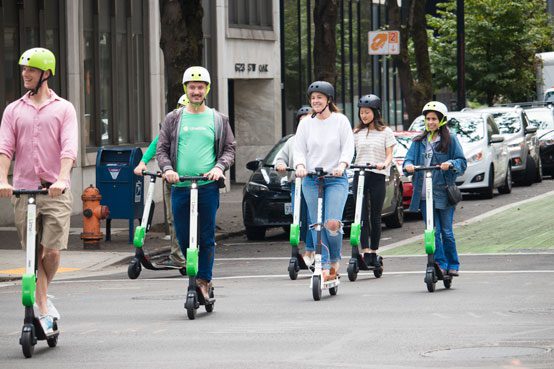Are E-Scooters a Menace or Needed Innovation?

Are today’s new motorized electric scooters an epidemic terrorizing American cities? In the New York Times, Nashville writer Margaret Renkl argues that the shared vehicles known as e-scooters are often abandoned in inappropriate places—such as in front of doorways, in the middle of the sidewalk, and on street corners. Renkl presents this as an inconvenience that outweighs all the benefits she mentions, including convenience, ease of use, affordability, reductions in urban heat and pollution, and less street congestion.
Renkl is certainly not alone in her skepticism. Her home city Nashville has decided to ban e-scooters after the tragic death of a rider who was struck by a car. Elsewhere, cities are cracking down on how e-scooters can be used. A proposal moving through D.C. Council, for instance, would establish speed limits on e-scooters and ban their use between 10 p.m. and 4 a.m.
Yet as with any backlash against new technology, a narrow focus on the costs of e-scooters misses their potentially enormous benefits. In addition to helping ease congestion, e-scooters increase options for poorer communities with less access to cars and public transit. To facilitate increased access, for example, many cities require companies to place certain numbers of e-scooters in low-income neighborhoods and offer discounted rides.
This new policy is paying off. A recent study by Populus found e-scooter riders are more diverse across gender, ethnic, and income groups, and from neighborhoods that are traditionally underserved.
Whatever issues e-scooters raise about sidewalk obstruction and tripping hazards, cities with mature scooter programs in place have demonstrated that education and public-private collaboration can alleviate these concerns. Some e-scooter providers now require that riders snap a picture of where they park, in order to verify it is in an appropriate parking spot. If it is not, a fine is levied against the user’s account.
The second problem highlighted by Renkl is more serious: danger to riders. A recent Center for Disease Control (CDC) study of Austin, Texas found the injury rate on e-scooters to be 20 per 100,000 rides, and that only 1 of the 190 injured wore a helmet. This lack of safety equipment and misunderstanding of traffic rules can lead to devastating injuries. Yet often these problems lie not with the scooters themselves, but with those riding them.
Of course, accidents often occur even when the injured party has been following the rules. But if the argument against e-scooters is simply that adults cannot handle them safely because they don’t wear helmets and obey traffic laws, the solution is to increase enforcement. A Portland Bureau of Transportation survey shows e-scooters are already having an impact on reducing car trips and ownership. Given e-scooter, pedestrian, and bicycle fatalities most frequently occur when a motor vehicle is involved in the accident, banning a device that takes cars off the road is simply not a smart way to make our streets safer.
Renkl also expresses concern that the infrastructure needed for e-scooters can take years to build, noting “protected bicycle lanes don’t appear overnight.” She’s not wrong. Yet at the same time, cities across the United States are devoting millions of dollars to expand both protected and unprotected lanes for small micro-mobility devices. According to peopleforbikes.org, protected bicycle lanes have doubled every year since 2009. There are now more than 550 protected lanes across 82 cities in 34 states, and with many more in planning and construction stages.
The intense demand for transportation options like e-scooters has even caused cities that initially banned their operation to reverse course. Dozens of cities are now working with e-scooter companies and the public through pilot programs to find solutions to safety, operations, and enforcement concerns that strike an appropriate balance. As a result, e-scooter rides are far outpacing ride-hailing (such as Uber) in their speed of uptake—in part because they appeal to a broader class of users. This is just the beginning of a micro-mobility revolution. A host of new electric devices are primed to hit the market in the next few years, including those with built-in driver-assistance technology.
Innovation is driving policy, rather than the other way around, and that’s a good thing. But as with any new technology, there is an adjustment period in which users, providers and the public learn by doing. Fortunately, notwithstanding the political backlash, the broader public is responding with cautious optimism, both for the technology itself and the ability to address valid concerns through collaborative policy design. As these technologies and the policies governing them continue to prove themselves, the day will come when e-scooter riders and mobility curmudgeons alike learn to stay in their lane.
Lauren McCarthy is a Google Policy Fellow at the Niskanen Center. She is pursuing a PhD in public policy at the Schar School of Policy and Government at George Mason University, and researches the role of emerging technology in urban development.